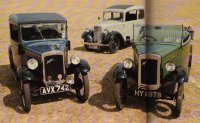From: Auto-totaal (Alle automerken van de wereld: Austin Morris Rover; Lekturama, 1986)
Development
The Austin seven was announced in july 1922 as the smallest british car with a four-cylinder engine, being 696cc.
1923
Engine capacity enlarged to 747 cc by enlarging the bore. The engine got a cooling fan and electric starter.
1924
Presentation of the Sports-Tourer.
1926
Presentation of the Seven Saloon.
1927
A model with linen coachwork was offered, but in 1930 disappeared again.
1928
Presentation of the 'Top Hat' coach; the radiator became nickle plated instead of painted.
1929
The lowered Ulster becomes available, with an optional extra Cozette compressor.
1930
The braking system now totally foot-operated.
1931
Wheelbase and rear track increased.
1933
Introduction of the four-speed gearbox, improved brakes and tyres. The Opal two-seater is presented alongside the lowered 65 Seven, with a tuned engine of 23 hp at 4800 r.p.m.
1934
The 65 became known as the Nippy, alongside came the Speedy-model. The third and fourth gear became synchronised. The Ruby and Pearl cabriolets appeared.
1936
The 747 cc engine got a third crankshaft-bearing, new cylinderhead and different sparkplugs. Power increased to 17 hp. For races a D(ouble)O(ver)H(ead)C(amshaft) engine became available. The cable-operated brakes were replaced by hydraulic Girling-brakes.
1939
The last Austin Seven built on january 17th.
Total production almost 300.000
Specification (1925):
Engine - watercooled four-cylinder in line, placed in driving direction, sidevalves.
capacity : 747 cc
bore x stroke: 56 x 76.2 mm
compression: 4.9 : 1
Carburator: Zenith sidedraught-carburator
Ignition: Magnet
Max power output: 10.5 hp at 2400 r.p.m.
Spokewheels; tyres 700 x 80
A-form (ladder) Chassis from U-profile steel
Length: 2692 mm
Width: 1168 mm
Wheelbase 1905 mm
Track front: 1016 mm
Track rear: 1010 mm
Weight: 330 kg
(tourer coachwork)
Max speed: 58 km/h
Cutaway drawing 1925 model
(klik for bigger version .. 277 Kb)

Models of 1930-1934
(klik for bigger version .. 150 Kb)


